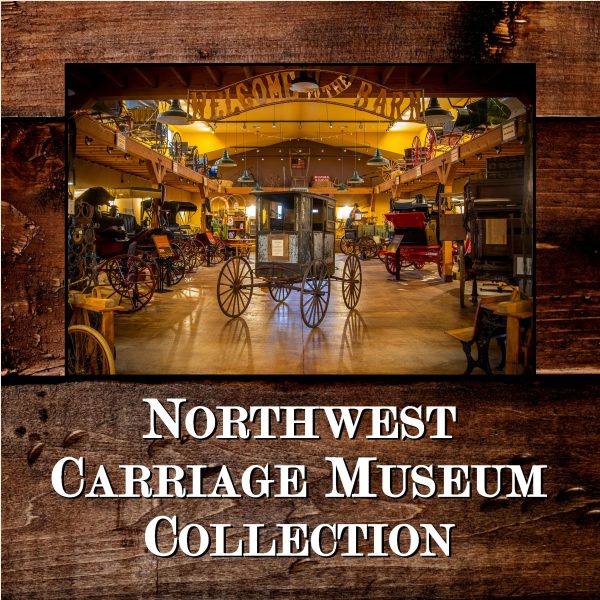


There were many types of bells used on horse-drawn sleighs back in the 19th century. There were of course the “jingle bells” or “crotals” that we now keenly associate with Christmas–the round, enclosed bell that contains a captured “jinglet”–but there were also open bells with a fixed clapper, and chimes of all shapes and varieties. These bells had more purpose than merely the romantic effect and beautiful sound: Snow-covered streets with sleighs whispering behind a horse made very little noise, so the bells signaled oncoming traffic and were mandated by law in many cities. Pictured on the left is a hame bell which were bracketed to the hames attached to the horse collar. In the middle are pole/shaft bells which attached to the sleigh shafts for single horses or to the pole for two horse setups–they could either mounted to the top or suspended below the shaft or pole. On the right is a saddle chime which was attached to the back saddle on the harness. Bells were usually brass and plated nickel, gold or silver, based on the customer preference. Our museum has an incredible collection of sleigh bells… come on in and take a look!

1880s Sleigh Runners on display in the Northwest Carriage Museum
So, it’s 1895 and your family is living on $300 to $400 a year. You own a buggy and one horse; you can’t afford a second vehicle, especially a rarely used sleigh. Oh no, it’s snowing and you need to make a run to town for supplies! What to do… what to do!? Get yourself some sleigh/sled runners! Take off them ol’ buggy wheels and strap on the runners–convert that ol’ buggy into a lean, mean snow machine! LOL! Seriously, though, our late 19th-century runners did just that: converted a wheeled horse drawn vehicle into a bob sleigh which could be used during snowy weather!
A complete set is on display at the museum.

Did you know that a buggy wrench was the only tool needed to assemble your new buggy back in the 1890s? Often, buggies and other vehicles were ordered from catalogs; in fact, you could order a new buggy from the Sears catalog back in 1895 for $29.95. That buggy would be delivered to your home (not by Amazon) and all you needed to do was uncrate it, find your buggy wrench, and put it together. That little wrench fit your hub nuts and every other square nut on that buggy. Once assembled, just hook up your horse and go to town. Here’s another good idea: best take that wrench with you… you never know what might be loose after a ride to town! This original wrench is from our 1895 Studebaker buggy. I have actually used it on our buggy… pretty handy!

 This beautiful Mitchell Farm Wagon was conserved several years ago and is currently on display in the museum. Michell Lewis was one of America’s finest wagon makers and was known for building strong and durable wagons out of Racine, Wisconsin during the second half of the 19th century. In 1882, William Mitchell, grandson of founder Henry Mitchell, opened a West coast facility in Portland, Oregon. Wagons being built in Racine were shipped via railroad to Portland, where they were sold. In 1892, Mitchell Lewis merged with Staver and Walker, producer of plows and related farm equipment. The new company was named “Mitchell Lewis and Staver.” Our wagon was originally bought by a farm family near Battle Ground, Washington in 1892. That family had it for many years and eventually sold it to another farm family who had it 61 years. Members from that family, while on a car club tour at our museum, offered to donate the wagon to us. We are the third owners of this historic vehicle. It was in the shop for several months, undergoing a complete conservation. We were able to save almost the complete vehicle–including original paint, pin stripping, and patina. The wagon is totally functional and very historical. Mitchell Lewis went on to make cars and trucks in the early 20th century. Mitchell Lewis Staver is still in business and based in Portland: they make and sell agricultural irrigation systems around the world.
This beautiful Mitchell Farm Wagon was conserved several years ago and is currently on display in the museum. Michell Lewis was one of America’s finest wagon makers and was known for building strong and durable wagons out of Racine, Wisconsin during the second half of the 19th century. In 1882, William Mitchell, grandson of founder Henry Mitchell, opened a West coast facility in Portland, Oregon. Wagons being built in Racine were shipped via railroad to Portland, where they were sold. In 1892, Mitchell Lewis merged with Staver and Walker, producer of plows and related farm equipment. The new company was named “Mitchell Lewis and Staver.” Our wagon was originally bought by a farm family near Battle Ground, Washington in 1892. That family had it for many years and eventually sold it to another farm family who had it 61 years. Members from that family, while on a car club tour at our museum, offered to donate the wagon to us. We are the third owners of this historic vehicle. It was in the shop for several months, undergoing a complete conservation. We were able to save almost the complete vehicle–including original paint, pin stripping, and patina. The wagon is totally functional and very historical. Mitchell Lewis went on to make cars and trucks in the early 20th century. Mitchell Lewis Staver is still in business and based in Portland: they make and sell agricultural irrigation systems around the world.











